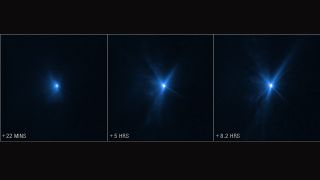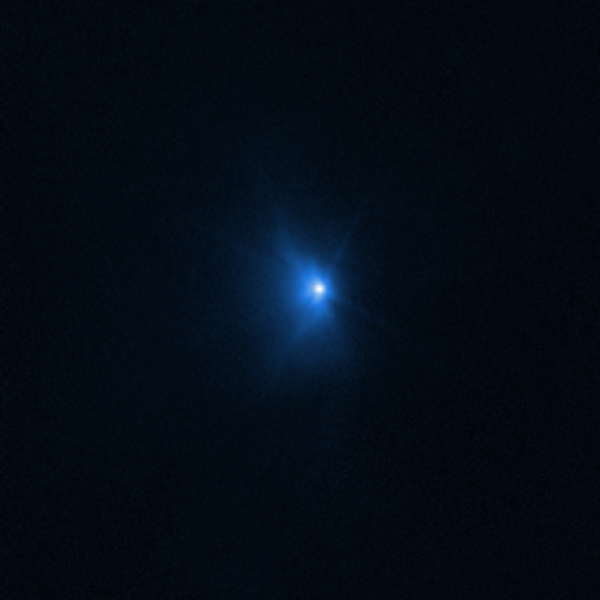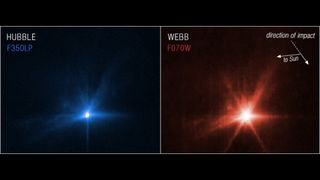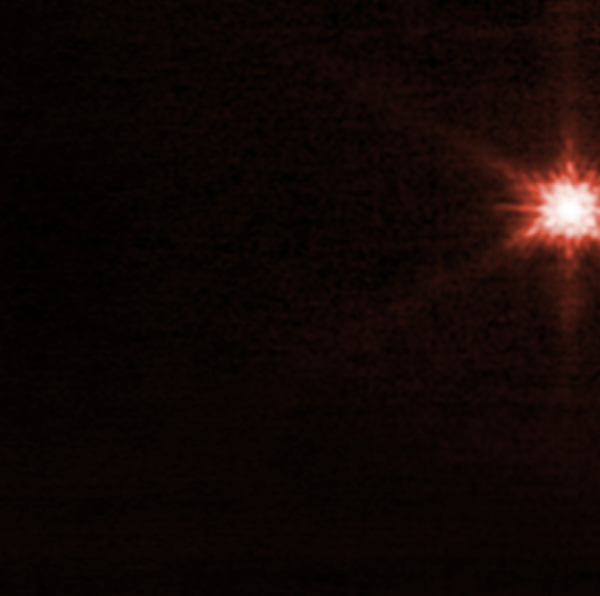DART asteroid crash seen by James Webb, Hubble space telescopes (photos)
"For the first time, Webb and Hubble have simultaneously captured imagery from the same target in the cosmos."

The James Webb Space Telescope and its older counterpart Hubble photographed the impact of NASA's asteroid-smashing DART probe into the space rock Dimorphos on Monday (Sept. 26).
The observations were the first job the two space telescopes performed in sync, according to NASA, and their collaboration will reveal new information about the battered asteroid. The James Webb Space Telescope observes the universe in the infrared (heat-emitting wavelengths), while the Hubble Space Telescope is a specialist in detecting optical light, the kind that is visible to the human eye. By combining observations from the two telescopes, astronomers can learn a great deal about objects in the cosmos.
Both Webb and Hubble observed the Didymos binary asteroid system before the collision of the 1,235-pound (560 kilograms) Double Asteroid Redirection Test (DART) spacecraft with the 525-foot-wide (140 meters) wide moonlet Dimorphos. Dimorphos orbits a 2,560-foot-wide (780 m) space rock called Didymos, and it's the orbit of the moonlet around the larger rock that the DART experiment was designed to alter.
Related: Behold the 1st images of DART's wild asteroid crash!
The asteroid pair, which at the time of impact was some 7 million miles (11 million kilometers) from Earth, appeared to Webb and Hubble like a dot of light that suddenly brightened when DART arrived. In the hours following the crash, the cloud of material stirred from the surface of Dimorphos spread away from that dot, gradually changing its shape.
According to Hubble measurements, the brightness of the Didymos system increased threefold in the wake of DART's impact, and this brightness persisted for more than eight hours.

Hubble took the images with its Wide Field Camera 3 instrument while Webb used its Near-Infrared Camera (NIRCam). Astronomers are still analyzing the images. They hope they might learn something about the surface of Dimorphos and the nature of the material ejected by the collision. For example, they might be able to tell whether the ejecta is mostly made of fine-grained dust or larger rocky fragments, the European Space Agency (ESA), which cooperates with NASA on both projects, said in a statement. Both telescopes will continue observing the asteroid system in the coming months, according to ESA.
Get the Space.com Newsletter
Breaking space news, the latest updates on rocket launches, skywatching events and more!

"Webb and Hubble show what we've always known to be true at NASA: We learn more when we work together," NASA Administrator Bill Nelson said in a NASA statement. "For the first time, Webb and Hubble have simultaneously captured imagery from the same target in the cosmos: an asteroid that was impacted by a spacecraft after a seven-million-mile journey. All of humanity eagerly awaits the discoveries to come from Webb, Hubble and our ground-based telescopes — about the DART mission and beyond."
The DART mission was the first experiment in history designed to alter the orbit of a celestial body. The so-called kinetic impact strategy demonstrated by the mission might one day save Earth from a collision with a stray space rock. (Dimorphos and Didymos pose no threat to our planet.)

Hundreds of ground-based telescopes all over the world are currently looking at the Didymos system to determine how much the orbit of the moonlet around the main rock changed after the impact. It might, however, take several weeks to get the exact result.
A small Italian cubesat called LICIACube, which traveled to the Didymos binary asteroid aboard DART but was released 11 days before the impact, observed the action as it unfolded from a distance of several hundred miles.
The double asteroid will also be the target of a dedicated European mission called Hera, which will explore the impact aftermath in great detail in 2027.
Follow Tereza Pultarova on Twitter @TerezaPultarova. Follow us on Twitter @Spacedotcom and on Facebook.
Join our Space Forums to keep talking space on the latest missions, night sky and more! And if you have a news tip, correction or comment, let us know at: community@space.com.

Tereza is a London-based science and technology journalist, aspiring fiction writer and amateur gymnast. Originally from Prague, the Czech Republic, she spent the first seven years of her career working as a reporter, script-writer and presenter for various TV programmes of the Czech Public Service Television. She later took a career break to pursue further education and added a Master's in Science from the International Space University, France, to her Bachelor's in Journalism and Master's in Cultural Anthropology from Prague's Charles University. She worked as a reporter at the Engineering and Technology magazine, freelanced for a range of publications including Live Science, Space.com, Professional Engineering, Via Satellite and Space News and served as a maternity cover science editor at the European Space Agency.
